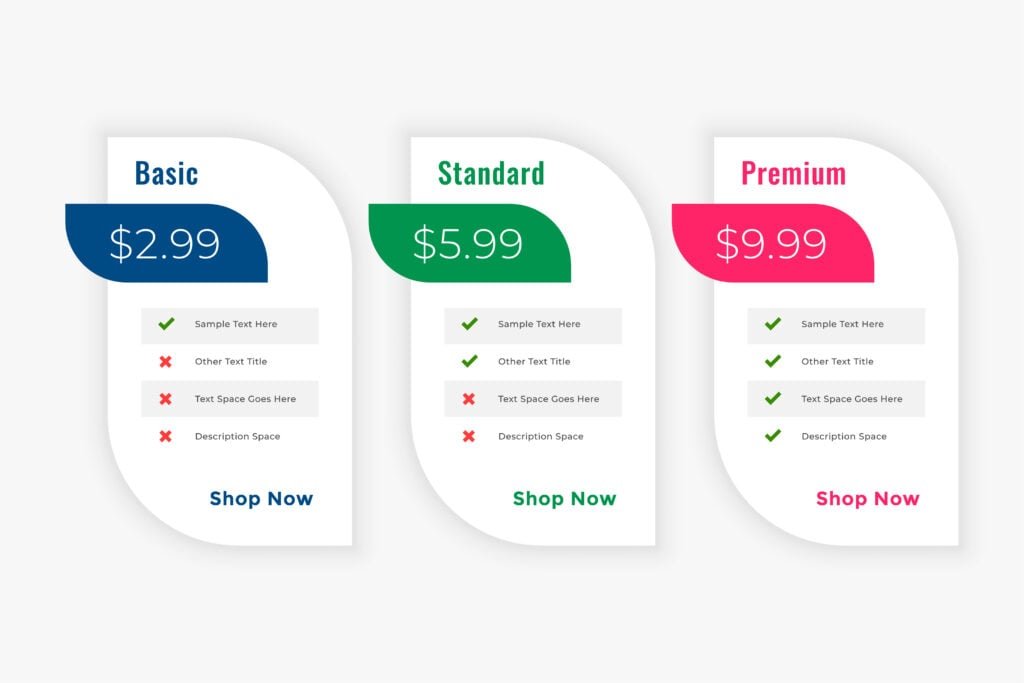Setting up a membership site can indeed provide a steady stream of recurring revenue for your business, offering financial stability and fostering a community around your content or services. Crafting an effective membership pricing strategy is crucial to attracting and retaining members while ensuring sustainable growth.
Exploring how to establish an effective membership pricing strategy involves careful consideration of various factors. To ensure the creation of a sustainable revenue stream for your business, let’s delve into key aspects to ponder and examine a selection of pricing models suitable for cultivating recurring income.
Factors to Consider in Developing a Membership Pricing Strategy
Developing a robust membership pricing strategy requires a thoughtful examination of several critical factors. First and foremost, clarity in articulating the value proposition is essential. This involves defining the unique benefits and exclusive content or services that members will receive, forming the foundation for an attractive offering. Subsequently, thorough audience research becomes imperative, delving into the demographics of the target audience and benchmarking against competitors to gauge industry norms. Cost considerations and profitability calculations follow, necessitating a careful evaluation of production costs and the establishment of profit margins to ensure financial sustainability.
- Identify content that is specifically reserved for members.
- Offer members early access to new products, services, or content before it becomes available to the general public.
- Provide members with exclusive discounts on products, services, or merchandise related to your business.
- Grant members access to industry experts thought leaders, or influencers.
- Offer expedited or priority customer support to members
The key is to tailor these benefits to align with the needs and interests of your target audience. By consistently delivering unique and valuable perks, you can create a compelling proposition that encourages individuals to become and remain loyal members of your community.
Also Read: Top Sites Like AliExpress for Dropshipping in 2024: The Best Alternatives
1. Membership Pricing Models

Membership pricing models refer to the structures and strategies businesses employ to determine how they charge individuals or entities for accessing exclusive content, services, or benefits within a membership-based platform. These models play a pivotal role in shaping the revenue generation and member retention strategies of organizations offering subscription-based services. Several common membership pricing models include:
- Monthly Subscription
- Annual Subscription
- Tiered Pricing Structure
- Freemium Model
- One-Time Access Fee
1. Monthly Subscription
The monthly subscription pricing model is a strategic approach where members are required to pay a recurring fee every month to maintain continuous access to the exclusive benefits and offerings provided by a membership-based platform. This model is characterized by its subscription-based structure, where individuals commit to making regular payments to retain their membership privileges.
One of the key advantages of the monthly subscription model lies in its ability to generate a consistent and predictable stream of income for the business. By securing a reliable monthly revenue, businesses can better plan and manage their financial resources, enabling more effective budgeting, resource allocation, and overall financial stability.
2. Annual Subscription
The annual subscription pricing model is a strategic arrangement wherein members commit to making a lump-sum payment for a full year’s access to the exclusive benefits and offerings of a membership-based platform. This model is characterized by its upfront payment structure, requiring members to pay for an entire year of access in advance.
One of the primary advantages of the annual subscription model lies in its ability to encourage commitment among members. By opting for a year-long commitment, individuals demonstrate a higher level of dedication to the membership, fostering a sense of loyalty and long-term engagement. This commitment is often incentivized through a discounted rate compared to the cumulative cost of monthly subscriptions over the same period.
3. Tiered Pricing Structure
The tiered pricing structure is a strategic membership model where businesses offer different membership levels, each with distinct benefits and corresponding pricing. This approach recognizes that members have diverse needs, preferences, and budget considerations, and aims to provide tailored options to accommodate this varied audience.
The tiered pricing structure allows businesses to cater to a broad and diverse audience, providing flexibility, personalization, and inclusivity. By acknowledging and addressing the varied needs of members, businesses can foster a vibrant and engaged community while optimizing revenue streams through a scalable and adaptable pricing strategy.
4. Freemium Model
The freemium model is a popular pricing strategy where businesses offer both free and premium versions of their product or service. In this model, basic features and services are provided to users at no cost (free), while more advanced or premium features are available at a price. This approach is particularly common in digital services, software, and content platforms.
Overall, the freemium model strikes a balance between attracting a wide user base through free offerings and generating revenue from a subset of users willing to pay for premium features. This model is effective for businesses seeking to maximize reach, create brand loyalty, and monetize their offerings in a flexible and user-friendly manner.
5. One-Time Access Fee
The one-time access fee model is a straightforward pricing strategy where users pay a singular, upfront fee for lifetime or extended access to a product, service, or membership. Unlike recurring subscription models, this approach involves a one-time payment that grants users continuous access without the need for ongoing payments.
While the one-time access fee model has its advantages, businesses adopting this strategy need to carefully consider the nature of their offerings and the expectations of their target audience. It’s particularly effective for products or services with enduring value, providing a win-win scenario where users gain immediate access, and businesses receive upfront financial support.
2. Types Of Pricing Strategies

We suggest two primary approaches to determine membership pricing: value-based pricing and competitor-based pricing. Here’s how to identify the optimal price using each method.
Value-based Pricing
Value-based pricing for a membership website involves setting the membership fee based on the perceived value that members derive from the exclusive content, services, and benefits offered. Instead of relying solely on production costs or competitor pricing, this strategy considers the unique value proposition provided by the membership.
Example: Value-Based Pricing for an Online Learning Membership:
Suppose a membership website offers exclusive access to high-quality educational content, personalized learning paths, live Q&A sessions with experts, and a supportive community of learners. Through surveys and feedback, it’s determined that members highly value the personalized learning experience and direct interaction with experts.
The value-based pricing strategy would involve setting the membership fee at a level that reflects the premium placed on these exclusive features. For example, if members indicate a willingness to pay more for personalized learning and expert interaction, the pricing structure would be influenced by these specific aspects of the membership offering.
In this scenario, the value-based pricing ensures that members feel they are getting a worthwhile return on their investment, creating a sustainable model that aligns with the unique value proposition of the membership website.
Competitor-Based Pricing
Competitor-based pricing for a membership website involves setting the membership fee by considering the pricing strategies of similar or competing membership platforms in the market. This approach aims to position your pricing in alignment with what your competitors are offering to attract a similar target audience.
Compile a list of successful competitors and membership services within your niche through various avenues:
- Gather insights from your existing members by asking them about services they considered or subscribed to before joining your platform.
- Utilize search engines and online communities like Quora with specific keywords such as ‘best [your niche] classes’ or ‘best [your niche] videos’ to identify potential competitors.
- Explore the pricing pages of identified competitors to understand their fee structures, examining the features offered and the variety of pricing packages available.
- Delve into customer reviews to gain valuable perspectives on competitors’ pricing.
- Investigate whether competitors provide free trials or freemium options to attract users.
After identifying your key competitors, focus on their pricing strategies:
- Analyze the features and benefits that competitors include in their memberships.
- Examine the number and structure of pricing packages competitors provide.
- Read customer reviews to gain insights into how customers perceive the pricing of your competitors.
- Determine if competitors offer free trials or freemium options.
- Evaluate the overall value provided by competitors in comparison to their pricing.
For example, if a competitor charges $9.99 per month for yoga classes without an integrated community, but your platform offers this added value, your pricing should reflect the enhanced features. Use this comprehensive competitor research to inform your pricing strategy and ensure that your membership fees align with the unique value proposition of your platform within the niche.
3. How To Set Membership Prices

Having explored various pricing models and strategies, let’s now delve into a couple of numerical considerations crucial for determining your membership pricing.
Consider Your Expenses
Setting membership prices requires a strategic approach that considers various factors to ensure that the pricing is both competitive in the market and aligned with the value provided to members. Here is a step-by-step guide on how to set membership prices:
1. Define Your Value Proposition:
Clearly articulate the unique value proposition of your membership. Identify the exclusive content, services, or benefits that set your offering apart from competitors.
2. Understand Your Target Audience:
Analyze the demographics, preferences, and spending capacity of your target audience. Consider what they value most and how much they are willing to pay for the benefits you provide.
3. Consider Production Costs:
Calculate the costs associated with producing and maintaining your membership content or services. Ensure that your pricing covers these costs while allowing for a reasonable profit margin.
5. Evaluate Perceived Value:
Assess the perceived value of your membership offering from the perspective of your target audience. Consider conducting surveys or focus groups to gather insights on what features or benefits members find most valuable.
6. Test Different Price Points:
Conduct pricing experiments or A/B testing to gauge how different price points impact user conversion rates. This empirical approach can provide valuable insights into optimal pricing.
7. Factor in Marketing and Acquisition Costs:
Consider the costs associated with marketing efforts and acquiring new members. Ensure that your pricing allows for sustainable customer acquisition and retention while covering associated expenses.
8. Determine Trial Periods or Freemium Options:
Decide whether to offer trial periods or freemium options to attract new members. These can serve as effective strategies for converting potential customers into paying members.
9. Monitor and Adjust:
Regularly monitor the performance of your membership pricing. Analyze metrics such as conversion rates, member retention, and revenue growth. Be prepared to adjust pricing based on market changes or shifts in member preferences.
10. Seek Member Feedback:
Actively seek feedback from your members regarding your pricing. Understand their perspectives on value for money and be open to making adjustments based on constructive input.
Setting membership prices is an ongoing process that requires a balance between covering costs, providing value, and staying competitive in the market. By systematically considering these factors and staying attuned to your audience and the market, you can establish pricing that fosters member satisfaction and contributes to the overall success of your membership offering.
Wrapping It Up
The selection of membership pricing models, such as monthly or annual subscriptions, tiered structures, freemium options, or one-time access fees, further contributes to the flexibility and appeal of your offering. Remember, the key is to continually monitor, evaluate, and adjust your pricing strategy based on market dynamics and member feedback.
As you embark on the journey of setting membership prices, keep in mind that a well-crafted pricing strategy goes beyond mere numbers; it reflects the value you provide to your community. Strive for a balance that not only ensures financial stability for your business but also fosters loyalty and satisfaction among your members. With a thoughtful and data-driven approach, your membership pricing can become a cornerstone for building a thriving, engaged, and sustainable community around your content or services.
Interesting Reads:
8 Best WordPress Themes for Auto Repair Services in 2024







